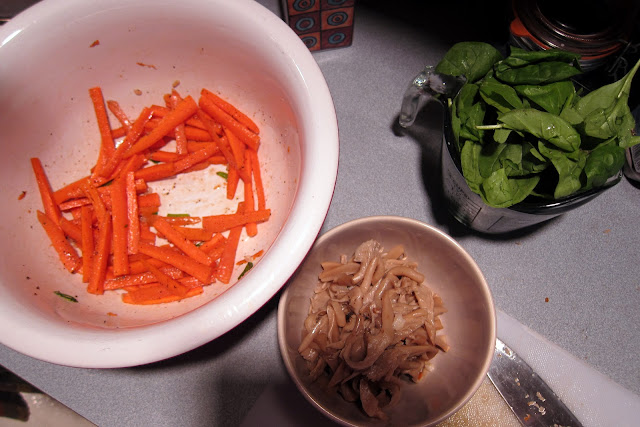고추장 - Guchujang - is a spicy, salty, sweet paste made of a red pepper called "gochu." Honestly, I wasn't the biggest fan of it when I first started eating it in Korea, but it grew on me quickly, and now I love it. As a matter of fact, it's an essential ingredient in one of my favorite Korean dishes: Bibimbap. So, naturally, that's exactly what I wanted to make the first chance I got. It was a little bit of a process to prepare and assemble all the components. But I didn't want to take the easy way out, because half the enjoyment of eating Bibimbap is appreciating the neat and colorful presentation and then mixing it all up! First I cut up a block of extra firm tofu and marinated it for a few hours in garlic, agave (instead of sugar), soy sauce, ground black pepper, white wine, and sesame oil.
Bibimbap is often eaten with some kind of animal meat, like chicken or beef, but it's also fairly common to have the tofu option in some Korean restaurants. If the tofu isn't available, I just ask for no meat and am good to go. (I also forego the fried egg or soft egg yolk that's often placed on top.) Here, tofu cooking in a frying pan with enough oil that it doesn't stick to the pan, turned so all sides get brown and crispy.
Bibimbap always has lots of vegetables, and restaurants vary on which they use. Two of the most common vegetables used in Bibimbap are the stem of a brown plant called bracken fiddlehead and a white root vegetable called bellflower. Neither of those are available at your average PA grocery store or farmer's market, so I used what I had available: carrots, canned abalone mushrooms, spinach and zucchini (not in the picture).
All of those veggies are actually pretty standard in typical Bibimbap, so I was managing to keep it fairly authentic! I kept each of the four veggies in their own bowls, mixed up with sugar, salt, and ground black pepper. One type of vegetable at a time, I worked my way through sauteing each in sesame oil just until they were a little tender, but still crisp. Of course it would have been easier to toss them all in one frying pan together, but then you wouldn't be able to create this snazzy arrangement:
비빔밥 - Bibimbap - even the name looks fun. Scoops of brown rice covered with separated sections of carrots, spinach, mushrooms, zucchini, and tofu, topped with a big squeeze of fiery red gochujang. 밥 - Bap - means "rice" and 비빔- Bibim - means "mix." So once it's oh so nicely arranged.....
.....you mix it up!
Each spoonful has that tasty gochujang spicing up the tofu, vegetables and rice. It's hardy and crispy and crunchy and warm and filling. Yum yum! Thanks to my sister Sarah for printing out this recipe for me last year when I first came back from Korea. We made it together in California last year, and I think I pulled it off pretty well this time around on my own!
Oh but wait, what's this hiding in the oven?
Just a little somethin' I created from this fun book:
It had one section that included a few dairy-free and egg-free recipes, including one called Banana Cookies. What a great recipe - only 5 ingredients: bananas, oatmeal, dates, vanilla extract and oil.
Mash up three bananas, finely chop one cup of dates (I did under a cup because they were sweetened with sugar and I didn't want the sweetness to be overpowering), pour in two cups of rolled oats, add 1/3 cup of oil and 1 tsp of vanilla....
And then 비빔, i mean, mix it up and let sit for about 15 minutes.
Place flattened spoonfuls onto a lightly greased baking sheet and bake for 15 minutes or less at 350 degrees F (175 degrees C). (I put some non-vegan chocolate chips on a few cookies for my parents.) Plated up for them:
And a nice little plateful with soy milk for me!
They're browned and crispy on the outside and soft and chewy on the inside. Isn't that perfect?
The ripe bananas get so sweet when they're cooked that you really don't need any sugar or sweetener. I would try to buy non-sweetened dates next time (as well as some vegan chocolate chips!), but I was perfectly content with these gobs of happiness just as they were. They kept great for a few days in an air-tight container. I just popped them in the microwave each time I wanted a little dessert, and they were warm, soft and satisfying. Especially when washed down with cold soy milk. :)
















4 comments:
oh my gosh, I'm gonna try those cookies!! they look delish!
Go for it! They are really tasty! Let me know if you like them! :)
Yum! Makes me wish I didn't make the kids finish those ripe bananas!
Yeah, they would love these cookies! Who's ever had the chance to try BANANA cookies?? :)
Post a Comment